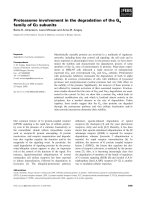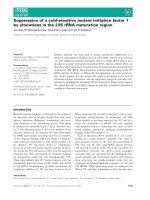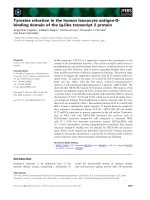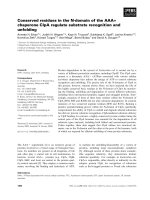báo cáo khoa học: " Review of "In the Eye of the Needle: Diary of a Medically Supervised Injecting Centre" by Ingrid van Beek Allen & Unwin 2004" potx
Bạn đang xem bản rút gọn của tài liệu. Xem và tải ngay bản đầy đủ của tài liệu tại đây (170.86 KB, 3 trang )
BioMed Central
Page 1 of 3
(page number not for citation purposes)
Harm Reduction Journal
Open Access
Book review
Review of "In the Eye of the Needle: Diary of a Medically Supervised
Injecting Centre" by Ingrid van Beek Allen & Unwin 2004
Allan Clear*
Address: Executive Director, Harm Reduction Coalition, 22 West 27th Street, 5th Fl, New York, NY 10001, USA
Email: Allan Clear* -
* Corresponding author
However they are labeled, there are a couple of dozen safe
injection facilities, safe injection rooms, safe injection
spaces, drug consumption rooms, or medically supervised
injecting centres around the globe. The most recent have
appeared in Vancouver, Canada, and the most scrutinized
is in Sydney, Australia. Dr. Ingrid Van Beek has diarized
the early history of Sydney's centre in her book, "In the
Eye of the Needle". This book is much more than the story
of the medically supervised injection center. The lessons
imparted here are invaluable for everyone working with
drug users and have universal application. Van Beek skill-
fully weaves several different strands throughout the book
including the mechanics of opening and running the
center; the emotional toll it takes on staff; the humanity of
the drug users the center serves; the need of the clients;
and the scrutiny that an institution comes under for being
deemed "controversial". Ultimately this book is about
how compassion, healthcare, dignity and human rights
can be obtained for drug users.
Medically supervised injection centres are controlled envi-
ronments aimed at reducing the negative consequences of
injecting in public places and are usually staffed by medi-
cal professionals and social workers. Injecting in uncon-
trolled spaces leads to missed and hurried shots, overdose
risk and "offending" the general public. Supervised injec-
tion centres emerged in Western Europe in the 1990s,
principally in Switzerland and Germany, and evaluations
of the centres have shown them to be an effective inter-
vention and a practical tool for health promotion among
drug users. The centres are particularly appropriate in
locations with thriving street based drug markets. As expe-
rienced in Vancouver and Sydney, it is not uncommon for
injection rooms to be foreshadowed by activists who first
set up illegal spaces and then gain legal status as a result
of government support.
Despite the corny title, "In the Eye of the Needle" is the
best book yet written on the experience of working in the
field of harm reduction. It sounds like I'm damning with
faint praise because, as far as I know, there are no other
books that explore the worker's experience. But no, this is
really a great book. You do not have to open a safe injec-
tion room to relate to everything that occurs herein.
Involved in drug services, needle exchange, housing, men-
tal health, drug treatment? The book covers, all too famil-
iarly, the issues – site location, back stabbing by
colleagues, under appreciation of hard working staff,
tears, sweat and blood everywhere. More blood than you
can possibly imagine. Blood on the walls and blood on
floor. We're talking about people shooting up. Favorite
drug users die and colleagues who you don't know are
using, overdose. Opposing politicians and the media are
scurrilous, self-serving, immoral hypocrites. At the same
time, politicians and media come through with the sup-
port when needed, always by a hair's breadth and often
without getting any substance behind the facts. It's a
lonely business sometimes. The only people who seem to
know what goes on are the workers. And the drug users.
Read this book and plot out a media strategy.
Dr. Ingrid van Beek was already running primary health
care services for drug users when she was contacted by a
local police chief concerned about the volume of emer-
gency calls for overdose situations. She took on the over-
sight of the medically supervised injecting centre on top of
Published: 15 September 2005
Harm Reduction Journal 2005, 2:15 doi:10.1186/1477-7517-2-15
Received: 12 July 2005
Accepted: 15 September 2005
This article is available from: />© 2005 Clear; licensee BioMed Central Ltd.
This is an Open Access article distributed under the terms of the Creative Commons Attribution License ( />),
which permits unrestricted use, distribution, and reproduction in any medium, provided the original work is properly cited.
Harm Reduction Journal 2005, 2:15 />Page 2 of 3
(page number not for citation purposes)
her day job and spent the next couple of years running
from centre to centre. The organizing work was intense
and all encompassing. Van Beek worked with everyone
from the local residents and business groups to govern-
ment representatives and law enforcement. At the same
time, the United Nations International Narcotics Control
Board decided to criticize the centre, overlooking for
arcane reasons the pre-existing European injection spaces,
causing more political fall out for the centre.
As a clinician, Dr. van Beek is the perfect foil for taking on
controversial services. She handles the burdensome site
visits from the police and health authorities with a stellar
resignation. "Although I pointed out that no other health
facility in the land is routinely inspected by licensing
authorities without notice, it was argued that some in the
community might expect this and we must be seen to be
absolutely squeaky clean in all respects." Who in the harm
reduction field does not feel that we are held to a different
standard than other services? The medically supervised
injecting centre, as described in the book, is clinical in
design as opposed to the more relaxed community ori-
ented European model of injection rooms. Smoking is not
allowed. Users cannot hang out. In 18-months, the centre
handled 554 overdoses without loss of life and thousands
of injection episodes. The most poignant moment in the
book is the frustration of receiving an evaluation that
minimized the success of the centre by giving it a marginal
passing grade. Rigor is fine in research but researcher rigor
mortis is sad. The number of deaths the opening of the
centre prevented cannot be quantified. Prevention is hard
to prove conclusively. Too often research is cautious and
verges on the ridiculously conservative. It seems this was
the case here.
Aside from describing the creation of the centre, this book
is a much-needed primer for overdose prevention. Over-
dose deaths can be largely prevented with appropriate and
timely care. When the centre first opened, Sydney experi-
enced a heroin drought and most users in distress were
revived with oxygen. Only as the drought was ending and
heroin purity increasing did the centre use naloxone, and
then only infrequently. "Increasingly," van Beek writes, "I
appreciate that the injecting centre provides a unique set-
ting in which health care workers actually see the overdose
occurring from the very outset, identifying symptoms of
heroin (or whatever drug) overdose and administering
appropriate treatment very soon thereafter. This can't and
doesn't occur in any other circumstance. By treating an
overdose so early in its course, the damage already done
and its natural progression is reversed so that Narcan
(used to start breathing) will no longer be needed in most
cases. This is how injecting centres potentially reduce the
morbidity (damage to vital organs, especially the brain)
and the mortality otherwise associated with overdose in
unattended situations, even when there is a very prompt
and efficient ambulance service on hand."
Globally, overdose has not had the attention that HIV pre-
vention for drug users has received. It is an issue, however,
that deserves equal attention. Whereas syringe exchange
programs emerged rapidly as an HIV prevention strategy
in the United States at the beginning of the nineties –
seven programs in the late 1980s to 90 programs five years
later – overdose prevention and education, however, have
not expanded in the same fashion. 5 campaigns in five cit-
ies or states in five years is inadequate considering, west of
the Rockies, drug users are more at risk of dying of an opi-
ate overdose than from HIV. In France, scaling up of
buprenorphine (Subutex) has greatly reduced mortality
from opiate overdose. In Russia overdose is common,
syringe exchanges are stagnant, and substitution therapy
is illegal. In such a milieu, it is hard to envision a super-
vised injection center. Van Beek's detailed account of such
a center can help the uninformed understand the mechan-
ics of overdose first hand. One of the strengths of the book
is that it is detailed enough to be of universal help in guid-
ing one to develop overdose interventions for drug users
without having to open a centre.
Aside from overdose prevention, safe injection rooms are
primarily thought of as nuisance abatement strategies.
Although not touched upon in the book, they are good
venues for safe injection education on reducing soft tissue
infections and disease prevention. At the recent Interna-
tional Harm Reduction Conference in Belfast, staff from
the Sydney medically supervised injecting centre talked
about the lack of blood awareness and the poor injection
techniques of injectors, despite years of education by pro-
viders. Investigation by staff at the centre revealed that
education such as rotating veins or releasing tourniquets
before injection weren't necessarily practical for the user.
This poses new challenges for providers and users alike,
but it is a path we need to travel together.
It has been less of a challenge to incorporate harm reduc-
tion as a national approach to drugs in countries with
health care systems that help people when they get sick, as
opposed to systems that benefit insurance and pharma-
ceutical companies when a consumer needs services. It is
also less challenging in countries that recognize that drug
users are citizens with rights. This book, however, points
up that even within a country, such as Australia, which
prides itself on pragmatism, it is still difficult to imple-
ment an intervention that can benefit the lives of drug
users. The story of the development of the medically
supervised injection centre is a classic case of harm reduc-
tion struggling to assert its worth. Despite the success of
the centre, there is no intention of replicating the facility
in other places in Australia. It has not inspired other coun-
Publish with Bio Med Central and every
scientist can read your work free of charge
"BioMed Central will be the most significant development for
disseminating the results of biomedical research in our lifetime."
Sir Paul Nurse, Cancer Research UK
Your research papers will be:
available free of charge to the entire biomedical community
peer reviewed and published immediately upon acceptance
cited in PubMed and archived on PubMed Central
yours — you keep the copyright
Submit your manuscript here:
/>BioMedcentral
Harm Reduction Journal 2005, 2:15 />Page 3 of 3
(page number not for citation purposes)
tries to follow suit (except for Vancouver, Canada) and
injection centres are taking the path of other interventions
for drug users in that they will be adopted gradually at a
glacial pace.
I would love to see a spate of books inspired by "In the Eye
of the Needle: Diary of a Medically Supervised Injecting
Centre". We could come up with our own "Catch 22" or
"One Flew Over the Cuckoo's Nest" to match the
Kafkaesque world we inhabit. In the meantime we have
with "In the Eye of the Needle", a readable, intelligent,
quality account of the creation of a harm reduction pro-
gram.









